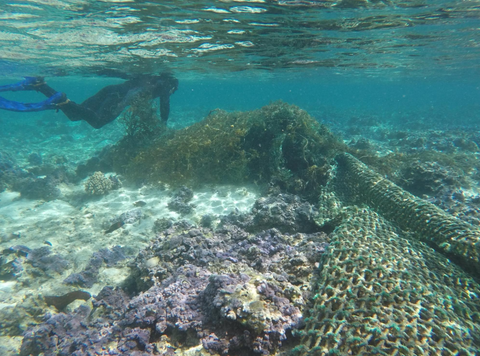Ghost Nets

The commercial fishing industry provides food and livelihoods for many countries across the world. Unfortunately it's also one of the main sources of ocean pollution. Ghost nets is a term used to refer to fishing nets that have been lost or abandoned in the ocean. These nets pose a serious threat to marine life who can get caught in the nets and die. Marine animals like sea turtles and dolphins are often unable to see these nets or detect them via sonar which causes them to unknowingly swim into the nets, getting tangled. For some marine organisms, these nets prevent them from moving freely and they eventually starve. For other marine organisms these nets cause severe injuries that can prove deadly.

Image Source: WWF
In addition to hurting marine organisms, ghost nets can also destroy marine habitats like coral reefs. Currents can drag ghost nets over coral reefs which catch on the coral breaking off pieces and leaving the corals vulnerable. Ghost nets can also cover up sea grasses and coral, preventing sunlight from reaching them.

Image Source: NOAA
Most fishing nets are made of plastic compounds like nylon, meaning ghost nets further contribute to the amount of plastic in our oceans. This is a major problem because nylon and other plastic compounds take hundreds of years to break down. While these nets will never completely break down, they will break into smaller pieces called microplastics. These microplastics pose a threat to marine life who can mistake microplastics for food and consume them. These microplastic can be toxic and cause internal harm to the animals that ingest them.

Image Source: Env Media
One solution to ghost nets comes from an unlikely source, the luxury fashion brand Prada. As a way of reusing old ghost nets Prada has developed their ECONYL thread made from old nylon products like fishing nets. This ECONYL thread is used to make regenerative nylon fabric used in Prada’s Re-Nylon capsule collection. This process removes the nets from the ocean and prevents them from ending up in landfills or incinerators.

Image Source: Vogue
In addition to Prada’s innovative reuse of nylon, efforts are being made around the world to remove ghost nets from the ocean. In New Zealand, Ghost Diving New Zealand is a volunteer operation run out of Wellington, New Zealand that works to remove ghost nets from the ocean. Removing these nets is a very difficult task, the process includes many challenges like locating the nets, untangling the nets, and safely removing them. These fishing nets can be up to 6 miles long, making them incredibly difficult to remove. The nets also often get caught in current which can carry them long distances which can make it tough to locate nets. Despite these challenges, organizations like Ghost Diving New Zealand have been successful in locating and removing large quantities of nets and other ocean plastic.

Image Source: Ghost Diving New Zealand
While these cleanups are incredibly admirable and important, they are not the ultimate solution to stopping the destruction of ghost nets. Changes must be made to the commercial fishing industry and fishing gear in order to prevent fishing nets from being lost or abandoned. One solution would be to outfit fishing nets with tracking devices so that they can not be lost. Another solution would be programs that offer a refund on fishing nets when they are recycled rather than abandoned. However it is accomplished, ghost nets need to be stopped in order to protect vulnerable marine life.
Sources
https://www.worldwildlife.org/stories/our-oceans-are-haunted-by-ghost-nets-why-that-s-scary-and-what-we-can-do--23
https://www.fisheries.noaa.gov/feature-story/impacts-ghost-nets-coral-reefs
https://www.nationalgeographic.com/environment/article/partner-content-prada-renylon-wellington-new-zealand
https://www.plasticsoupfoundation.org/en/plastic-problem/plastic-environment/ghost-nets/
About the Author: Emma Gamble is a junior at the George Washington University majoring in Environmental Studies and minoring in public policy. Emma is passionate about incorporating greater sustainability into our food systems in order to create a greener future for people and the planet. Emma enjoys sailing, kayaking, and paddle boarding.

